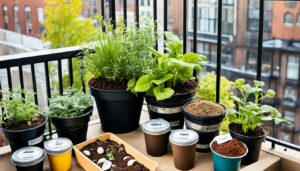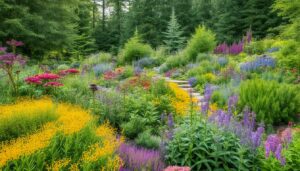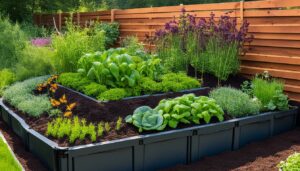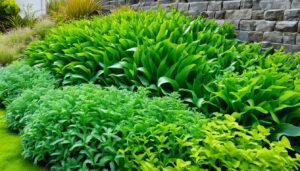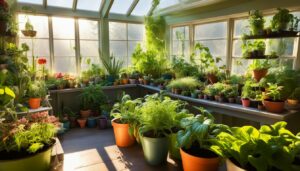Imagine strolling through your garden, the air is cool, and the lush greenery envelopes you in a tranquil embrace. It’s not your typical sun-drenched space but a serene haven carved out within the shadows. Low-light gardening is making a monumental shift, transforming dim and shaded areas into vibrant assemblies of foliage and flowers. But how can you harness the potential of those forgotten corners for a thriving shade garden design?
Often misunderstood, creating a shade garden is not about settling for a monotonous sea of green. It’s about celebrating diversity and splendor just as you would in sunlit areas. With the right gardening shade plants, those elusive spots become alive with color and texture. From the architectural lines of ferns to the colorful bursts of toad lilies, landscaping with shade plants can yield a rich tapestry of plant life that defies the traditional reliance on full sun.
Key Takeaways
- Discover plants that not only survive but also thrive in shade, such as bleeding hearts and New Guinea impatiens.
- Learn how to design a layered shade garden for visual depth and beauty.
- Understand the importance of plant selection based on light conditions and soil moisture in shaded areas.
- Explore the surprising variety of colors and textures available for shade gardens.
- Gain insights into creating a lush, green oasis even without the benefit of full sunlight.
Understanding Shade in the Garden and Its Impact on Plant Growth
Shade in a garden can vastly differ, from the light dapple of a birch tree to the deep green gloom of a conifer forest. Recognizing these unique shade conditions and implementing shade gardening tips is pivotal for the wellbeing of shade-tolerant plants and ensuring lush growth. Gardening in shady areas isn’t about working against the lack of light; rather, it’s about creating a harmonious space where plants best suited to those conditions can flourish.
To assist gardeners in selecting proper plants for their shade gardens, the following table captures some popular shade-lovers alongside their specific shade needs and unique features:
| Plant Name | Type of Shade | Special Characteristics |
|---|---|---|
| Hydrangeas | Partial to Full Shade | Large blossoms ranging from blue to pink depending on soil pH |
| Lady Ferns | Deep Shade | Elegant green fronds that deepen in color with maturity |
| Chaenomeles (Flowering Quince) | Partial Shade | Produces golden-yellow fruit after flowering |
| Bleeding Hearts | Partial to Full Shade | Distinctive heart-shaped flowers in spring |
| Dogwood Trees | Partial to Full Shade | Splendid white spring blooms and autumn foliage |
| Dutchman’s Pipe | Partial Shade | Offers a dense foliage canopy and curious pipe-shaped flowers |
| English Ivy | Partial to Full Shade | A vigorous climber with evergreen leaves |
While moisture and nutrient competition are key factors to consider, so too is the microclimate created beneath the canopies where these shade-tolerant plants reside. A well-rounded understanding of each plant’s preference can lead to a remarkably textured and vibrant garden, showcasing that even the most shadowed garden corner can become a thriving habitat when paired with the right foliage and flowers.
Gardening Shade Plants: Creating a Lush Oasis in Low Light Areas
Transforming a shady area of your garden into a lush, verdant sanctuary is not only achievable but can also become one of the most enchanting parts of your landscape. Embracing the unique conditions of low-light gardening opens up a diverse world of best shade plants for gardens. Essential to creating a shade garden is choosing the right plants that adapt and thrive. As we delve into the horticultural art of Hosta gardening and ferns for shade, we uncover the beauty that thrives beyond the reach of the sun’s full glare.
Lush Foliage for Shady Gardens: Hostas and Ferns
Among the popular plants for shade, Hostas are beloved for their variety and enduring beauty. With foliage colors spanning the spectrum from lime green to deep blue and sizes from miniature tufts to sprawling leaves the size of dinner plates, Hostas are a testament to the variety available in shade gardening. Similarly, ferns offer a graceful touch to the shaded soil, with their delicate fronds unfurling in the cool understorey. Pair these two together, and you get a dynamic duo that anchors your shade garden with a reliable backdrop of greenery.
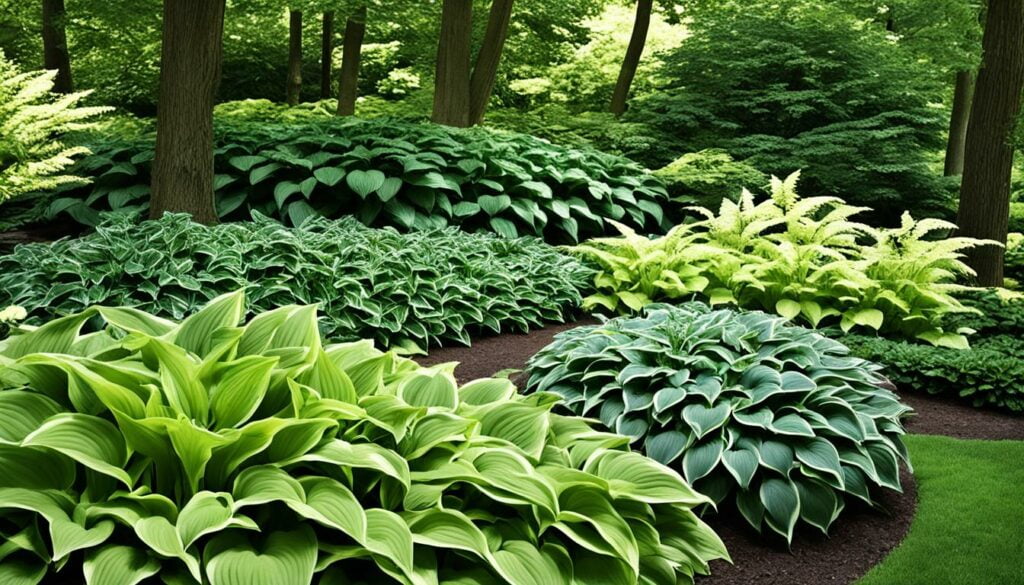
Adding Blooms to the Darkness: Astilbe, Bleeding Hearts, and Hellebores
The assumption that flowers cannot bloom in the darkness is delightfully disproven by species like flowering shade plants such as Astilbe, Bleeding Hearts, and Hellebores. These plants not only contribute vibrant splashes of color to shade gardens, but their distinctive forms are also sought after by those dedicated to gardening in shady areas. The feathery plumes of Astilbe in shade gardens, the romantic droplets of Bleeding hearts, and the winter-blooming Hellebores for shade collectively extend the beauty of the garden into the far reaches of the shade.
The Importance of Soil Moisture and Plant Selection
Creating a luxuriant shade garden further requires a nuanced understanding of soil moisture’s influence on plant health. In shadowed spaces where the sun’s evaporation effect lessens, plants like Astilbe require consistently moist soil, whilst some Hosta varieties bravely withstand drier conditions. Choosing the correct plant for your garden’s specific shade type and soil moisture is vital to ensure the success of your low-light gardening efforts.
| Plant | Soil Moisture Preference | Shade Tolerance | Bloom Period |
|---|---|---|---|
| Hosta | Varies (mostly dry tolerant) | Partial to Full Shade | Summer |
| Ferns (e.g., Lady Fern) | Moist | Full Shade | N/A (Foliage Plant) |
| Astilbe | Evenly Moist | Partial Shade | Late Spring to Summer |
| Bleeding Hearts | Moist, Well-Drained | Partial to Full Shade | Spring to Early Summer |
| Hellebores | Moist, Well-Drained | Full to Partial Shade | Winter to Spring |
Embracing the essence of gardening in shady areas is not only about selecting the right plant but also understanding the complete ecosystem of your garden. With the right ensemble of shade-loving flora, you can craft an oasis filled with verdant foliage and captivating blooms, despite the challenges of low-light gardening. Ensuring your space coalesces into a garden that buzzes with life year-round, making the most of the shaded canvas nature provides, is the heart of creating a shade garden. By leveraging these shade gardening tips, your dream of a serene garden retreat, cooled and softened by the shade, can come true.
Shade Garden Design: Aesthetic Techniques for Dim Spaces
The art of shade garden design extends beyond the mere selection of shade-tolerant plants. To achieve a truly captivating garden, one must consider the harmony of color, the interplay of textures, and the architecture of foliage that thrives within these serene settings. Gardening in shady areas becomes an experience that is as rewarding as it is beautiful, allowing for an array of botanical displays unattainable in the sun’s harsh glare.
Leveraging the understated elegance of shaded spaces begins with a well-thought-out plan. Here, we delve into the foundation of designing your own shade garden—layering diverse plant forms, introducing dynamic color schemes, and appreciating the unique challenges and opportunities of landscaping with shade plants.
- Textural Contrasts: Place the lacy foliage of ferns against the broad, veined leaves of hostas for a luxurious contrast.
- Colorful Accents: Introduce vibrant shade-loving flowers like astilbe and bleeding hearts to infuse pops of color in green expanses.
- Vertical Layering: Take advantage of the vertical space by using climbing plants like clematis to draw the eye upwards.
- Dramatic Focal Points: Create bold statements with Japanese maples or statuesque foxgloves that stand out against the subdued backdrop.
As curated spaces, shade gardens benefit from focal points and strategic placements of plant varieties that complement one another. The table below illustrates a small selection of such pairings, perfect for bringing your shade garden to life:
| Plant Type | Height | Texture | Color |
|---|---|---|---|
| Ferns | Short to Medium | Finely Divided | Various Greens |
| Hostas | Short to Tall | Broad & Veiny | Green, Blue, Variegated |
| Foxgloves | Tall | Silky Spikes | Purple, Pink, White |
| Astilbe | Medium | Fuzzy Plumes | Red, Pink, White |
| Bleeding Hearts | Short to Medium | Delicate & Drooping | Pink, White, Red |
Ultimately, the shade garden is a place of enchantment, a tableau painted with diverse flora that coexists in a dappled world beneath the trees. With thoughtful planning and a respect for nature’s nuances, even areas with minimal sunlight can be transformed into intimate spaces of tranquility and visual delight.
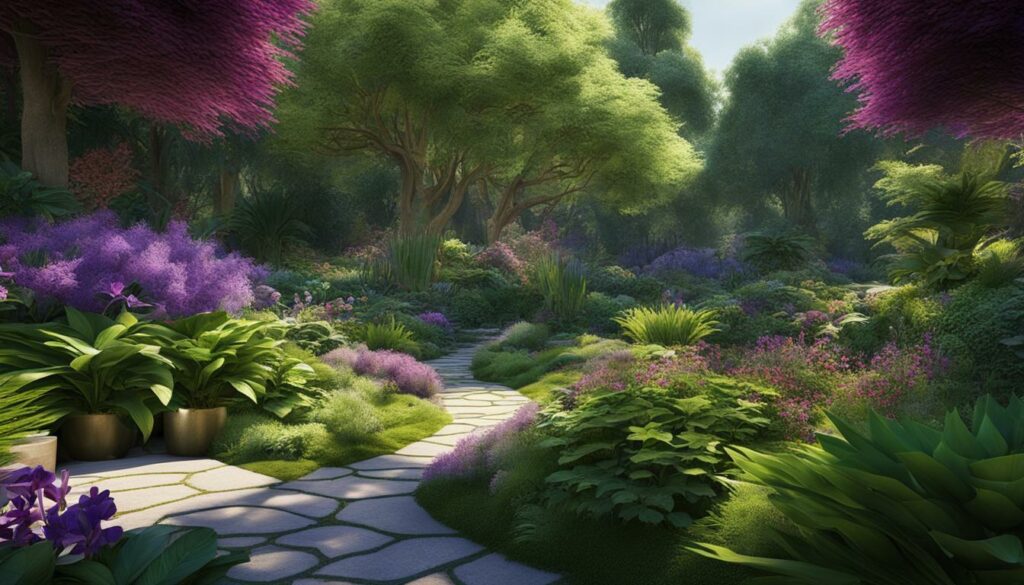
Conclusion: Embracing the Natural Beauty of Shade Gardens
The allure of the shaded garden is unquestionable, with the apt selection of the best shade plants for gardens, they flourish, showcasing the astonishing potential of low-light spaces. Creative endeavors in shade gardening not only foster a serene ambiance but serve as a catalyst for biodiversity, fusing the shades of green with a spectrum of colors and textures. In particular, Coleus and Heuchera emerge as stars of the shade, their intricate leaf designs adding depth and vibrancy to areas that sunlight seldom reaches. These varieties exemplify the splendor achievable in creating a shade garden, inviting an atmosphere of calm and a visual feast that kindles the senses.
The Benefits of Incorporating Shade-Tolerant Plants
Introducing popular plants for shade goes beyond mere aesthetics; it is an exercise in environment enrichment. Whether through the variegated foliage of Coleus, or the rich hues and hearty nature of Heuchera, these plants enrich low-light areas with life. Their structured layers and heights offer a verdant backdrop for other floral bursts while supporting local wildlife. Shade-tolerant plants transform latent garden corners into showcases of tranquility and beauty, proving that even in the subtle embrace of the shade, nature’s palette is rich and full of surprise.
Maintaining a Healthy Garden in Shaded Areas
Success in maintaining shade gardens rests on proper plant selection, mindful of shade levels and soil moisture. Combining low-light gardening knowledge with shade gardening tips, one can curate a collection of plants—like the fragrant lily of the valley and the robust Euphorbia—that embody resilience and beauty. Regular maintenance, embracing shade garden care, ensures these plants continue to prosper. Diligent pest monitoring, precise watering, and judicious pruning are the keystones of a sustainable, low-effort garden sanctuary. By recognizing the beauty of shade-loving flora, any gardener can craft and nurture an alluring and thriving shade garden as an extension of their living space.



